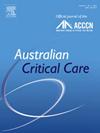Handgrip and inspiratory muscle strength as surrogates for intensive care unit–acquired weakness: A prospective cohort study in Taiwan
IF 2.7
3区 医学
Q2 CRITICAL CARE MEDICINE
引用次数: 0
Abstract
Objective
The objective of this prospective cohort study was to investigate the incidence of intensive care unit (ICU)–acquired weakness (ICUAW) and compare handgrip strength (HGS) and inspiratory muscle strength, measured by maximum inspiratory pressure (MIP), between critical illness survivors with and without ICUAW. Additionally, we examined whether HGS and MIP could serve as surrogate measures for ICUAW and establish reference cut-off values for both HGS and MIP in Taiwanese ICU survivors.
Methods
A total of 274 ICU survivors aged ≥20 yrs without prior systemic weakness from six medical ICUs at a tertiary care hospital in Taiwan were consecutively enrolled. ICUAW was identified at the time of ICU discharge using standardised manual muscle testing based on the Medical Research Council scale. Simultaneously, HGS and MIP were assessed. A receiver operating characteristic curve analysis was performed to evaluate whether HGS and MIP could serve as surrogate markers for ICUAW and to establish their cut-off values.
Results
Among the 406 enrolled participants, 310 survived their ICU stay, and 274 completed the Medical Research Council test upon ICU discharge. The survivors were predominantly male (65.7%), with a median age of 70 years (interquartile range: 59–80). Acute respiratory failure was the leading cause of ICU admission (52.9%), and 60.2% of patients required mechanical ventilation during their ICU stay, with a median duration of 8 days (interquartile range: 3–8). ICUAW was identified in 23.0% of survivors. Fewer participants in the ICUAW group were able to complete HGS (87.1%) and MIP (45.2%) assessments, likely due to physical limitations. Compared with those without ICUAW, the ICUAW group was significantly older, had higher Acute Physiology and Chronic Health Evaluation scores at admission, required longer mechanical ventilation, had longer ICU stays, and displayed weaker HGS and lower MIP at ICU discharge. The receiver operating characteristic curve analysis demonstrated that both HGS and MIP served as promising surrogate markers with areas under the curve of 0.842 and 0.822, respectively, and optimal cut-offs of 10.9 kg-force for HGS and 22.5 cmH2O for MIP. Additionally, sex-specific cut-offs were also identified.
Conclusions
HGS and MIP show promise as surrogate markers for ICUAW, with our ICU survivor cohort revealing comparable HGS and lower MIP cut-off values compared to previous recommendations. These results emphasise the importance of tailored cut-offs and screening approaches for different ethnic and geographic regions. Additionally, they provide preliminary reference values for ICU survivors in Taiwan and highlight the need for further studies in the region.
台湾的一项前瞻性队列研究:用握力和吸气肌力量替代重症监护病房获得性虚弱
本前瞻性队列研究的目的是调查重症监护病房(ICU)获得性虚弱(ICUAW)的发生率,并比较有和没有ICUAW的危重疾病幸存者的握力(HGS)和吸气肌力量(以最大吸气压力(MIP)测量)。此外,我们研究了HGS和MIP是否可以作为ICUAW的替代指标,并为台湾ICU幸存者的HGS和MIP建立了参考临界值。方法连续入选台湾某三级医院6个ICU患者,年龄≥20岁,既往无系统性虚弱的274例ICU存活患者。在ICU出院时,使用基于医学研究委员会量表的标准化手动肌肉测试确定ICUAW。同时对HGS和MIP进行评估。进行受试者工作特征曲线分析,以评估HGS和MIP是否可以作为ICUAW的替代标志物,并建立其临界值。结果在406名入组患者中,有310人在ICU住院期间存活,274人在ICU出院时完成了医学研究委员会的测试。幸存者主要为男性(65.7%),中位年龄为70岁(四分位数范围:59-80)。急性呼吸衰竭是ICU住院的主要原因(52.9%),60.2%的患者在ICU住院期间需要机械通气,中位持续时间为8天(四分位数范围:3-8)。在23.0%的幸存者中发现了ICUAW。ICUAW组较少的参与者能够完成HGS(87.1%)和MIP(45.2%)评估,可能是由于身体限制。与无ICUAW组相比,ICUAW组明显年龄较大,入院时急性生理和慢性健康评估评分较高,需要更长时间的机械通气,ICU住院时间更长,出院时HGS较弱,MIP较低。受试者工作特征曲线分析表明,HGS和MIP曲线下面积分别为0.842和0.822,HGS和MIP的最佳截断值分别为10.9 kg-force和22.5 cmH2O。此外,还确定了性别特异性截断。结论:shgs和MIP作为ICUAW的替代标记物具有前景,我们的ICU幸存者队列显示与先前推荐的HGS和MIP临界值相当。这些结果强调了为不同种族和地理区域量身定制的切断和筛选方法的重要性。此外,这些研究结果为台湾ICU幸存者提供了初步的参考价值,并强调了该地区进一步研究的必要性。
本文章由计算机程序翻译,如有差异,请以英文原文为准。
求助全文
约1分钟内获得全文
求助全文
来源期刊

Australian Critical Care
NURSING-NURSING
CiteScore
4.90
自引率
9.10%
发文量
148
审稿时长
>12 weeks
期刊介绍:
Australian Critical Care is the official journal of the Australian College of Critical Care Nurses (ACCCN). It is a bi-monthly peer-reviewed journal, providing clinically relevant research, reviews and articles of interest to the critical care community. Australian Critical Care publishes peer-reviewed scholarly papers that report research findings, research-based reviews, discussion papers and commentaries which are of interest to an international readership of critical care practitioners, educators, administrators and researchers. Interprofessional articles are welcomed.
 求助内容:
求助内容: 应助结果提醒方式:
应助结果提醒方式:


